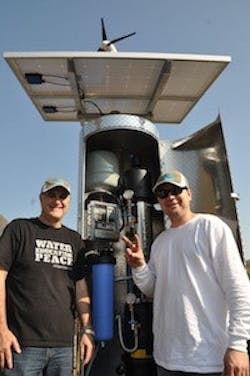SunSpring Filtration System Named Finalist in Aid Innovation Challenge
H2OpenDoors, a project of Rotary Club Intl., announced that the SunSpring is a finalist in the AidEx 2013 technology awards. Manufactured by Innovative Water Technologies of Colorado, SunSpring units are part of Rotary's efforts to overcome the realities of contaminated drinking water in the developing world. These filtration systems have already made an impact in desperate regions of Haiti, helping the nation recover from a devastating earthquake and numerous hurricanes. The systems are also operational in Africa and Asia providing relief in harsh conditions.
The Aid Innovation Challenge (AidEx) in Brussels, Belgium, recognizes individuals and businesses that have made breakthroughs in improving the lives of those in the developing world. AidEx provides a showcase for unique products and services in the areas of food and water, logistics and communication, medicine, and shelter.
"H2OpenDoors is not surprised that the SunSpring has earned global recognition. We already know that it is a remarkable piece of technology that's helping us change lives," said Jon Kaufman, member of Peninsula Sunrise Rotary Club. "Contaminated drinking water continues to be one of the most stubborn obstacles in the developing world; SunSpring has shown itself to be a viable solution."
SunSpring technology provides a sustainable, high-volume filtration unit. By not relying on pre-existing infrastructure, these units are suited for both disaster recovery situations and the developing world. The technology is portable, self-contained and powered entirely by solar panels and wind. Peak capacity of the SunSpring unit exceeds 20,000 liters a day, and the operation life is a minimum of 10 years.
Last February, H2OpenDoors installed a system in Huayjakan village in Thailand's Chiang Mai province; at the same time, a health baseline survey was carried out amongst the 2,500 local residents. More than a quarter of those surveyed were suffering from chronic diarrhea, a telltale symptom of E. coli contamination, which was traced to the village's primary water source. A follow-up survey conducted five months after installation showed a 75% reduction in incidence of diarrhea.
Source: H2OpenDoors
